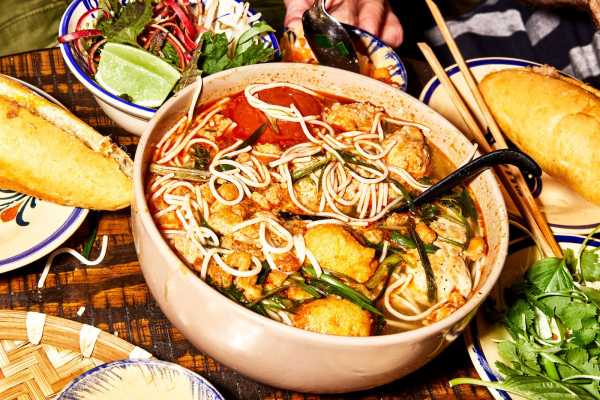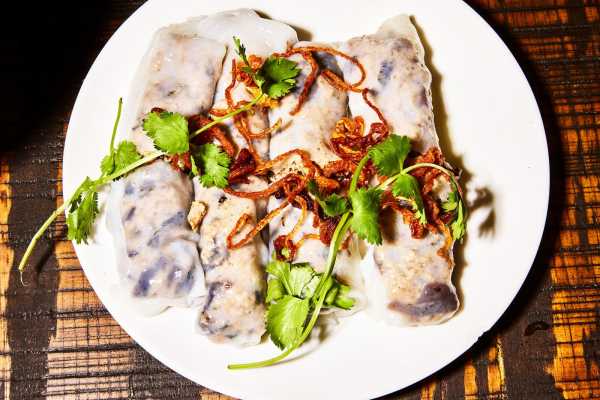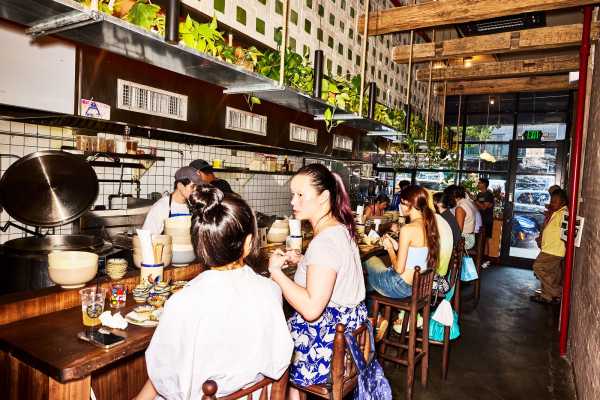
Save this storySave this storySave this storySave this storyYou’re reading the Food Scene newsletter, Helen Rosner’s guide to what, where, and how to eat. Sign up to receive it in your inbox.
Bánh, on the Upper West Side, is one of the city’s most reliably excellent Vietnamese restaurants, a beacon in an otherwise dull food neighborhood. It’s a sunny, casual spot serving excellent renditions of crowd favorites: enormous bánh mì stuffed with pickled vegetables and fatty pork belly, rich and aromatic bowls of phở, the butter-sizzled beef-noodle dish bún bò bơ. A few months ago, after much anticipation, Bánh’s chef-owners, Nhu Ton and John Nguyen, expanded their footprint downtown, to the East Village, with the opening of Bánh Anh Em. Anh em is Vietnamese for “brothers,” and the two restaurants do have an unignorable shared DNA, but the downtown spot feels more ambitious, more focussed, more mature. The beef phở features long-simmered broth scented with star anise and black pepper and the chewiest, springiest noodles, made fresh daily on an enormous, imported noodle-extruding machine whose retrofuturistic bulk crowds the space behind the bar. There are bánh-mì sandwiches, but, unlike the uptown restaurant, whose baguettes are sourced from Balthazar, Bánh Anh Em bakes its bread in house—enormous, airy rugby balls of yeast and flour, with crackly thin crusts and a crumb as light as soufflé.

Bún riêu, a tomato noodle soup.

Bánh cuốn hà nội dumplings are filled with ground pork, shrimp, and mushrooms, and topped with fried shallots.
What really sets the restaurant apart, though, is its attention to Vietnamese dishes that can be hard to find in New York City—even now, in the flush of evocative, exploratory, unreservedly ambitious new Vietnamese or Vietnamese-inspired restaurants such as Mắm and Ha’s Snack Bar. At Bánh Anh Em, you’ll find such rarities as bánh chưng chiên, a dense cake of sticky rice filled with sweet minced pork belly, a traditional dish for the Lunar New Year, whose preparation takes two to three days. (“I don’t think anyone else in New York City is making this,” a server said, as she carefully untied the aromatic banana-leaf wrapping in which the rice and meat had steamed.) The bún riêu, a soup made with those marvellous fresh noodles, features an international-orange tomato broth in which swim enormous, fluffy pork-and-crab meatballs, hunks of fried tofu, and slices of crispy pork. An order of the bánh mì pate, a style of sandwich that’s a specialty of the northeastern Vietnamese city of Haiphong, comprises two petite loaves, each filled just enough—not overstuffed, not mega-smeared—with smooth, sweet, funky pork pâté fluffed up with pork-floss batting. They come with a dipping dish of fermented sauce, hot and sour, to slice through all that richness, though I recommend taking your first bite without it: the crust of the bread shatters against your teeth, the crumb pulls tenderly, and the meaty filling reveals a potent, symphonic intensity.
The bánh beo features flat rice cakes with shrimp and pork.
Several precious feet of space in the restaurant’s trim open kitchen are dedicated to a volcanically hot charcoal grill, to properly impart the smoke and char that give the sweetness of so many dishes a dimensional, toffee-like edge. There are few things on this earth quite so satisfying as a Vietnamese pork chop, sliced cutlet-thin and bathed in sugar and fish sauce, cooked quickly to exquisite tenderness over blistery coals; that same heat, applied in the lightest kiss to meaty oysters on the half shell, ruffles their edges and merges their briny liquor with the scallion oil drizzled on top. The touch of the grill is felt in every corner of the room, like a high-sillage perfume made of the primal, appetite-turbocharging molecules of smoke and meat and sweetness. The space feels sturdy; I recall colors and comfortable seats and murals and plants, though to be honest the vividity of the food largely stole my attention from the room. I did note the nostalgic primary-color polka dots on the water glasses, and the wiggly wooden chairs carved with jaunty little rosettes, and the scalloping curve of round-table banquettes along one side of the dining area. The kitchen seemed to be just teetering on the edge of overwhelm—the menu’s lone dessert, on my visits, was never available—and the overarching feeling in the restaurant is one of joyous urgency.

The restaurant doesn’t take reservations, and the wait for a table often stretches to ninety minutes or more.
As always with great new restaurants these days, getting a table is a bit of an investment, though Bánh Anh Em takes the fundamentally democratic approach of allowing no reservations at all. Instead, in the hour before opening, a line grows to the corner, and by the time the doors unlock there’s a digital waitlist, which often stretches to ninety minutes or more. As an inveterate line loather, I can say with authority that it’s totally worth it. Put in your name, and then wander around for a drink somewhere or browse the racks at the ritzy secondhand shop two doors down. Those truly allergic to delayed gratification can order takeout online, from a slightly abridged menu, though be forewarned that those glorious bánh mìs start to lose their vividity as they vegetate inside their packaging, the distinct textures and temperatures devolving, with each ticking second, from extraordinary to average; if you’re ordering a sandwich to go, plan to tear into it immediately.
Helen, Help Me!
E-mail your questions about dining, eating, and anything food-related, and Helen may respond in a future newsletter.
Dining in, you get the pleasure of dishes not available on the to-go menu. Among these is bánh ướt chồng, a photo-ready centerpiece that’s a specialty of Chef Ton’s, originating from her home town of Buôn Ma Thuột. Its arrival involves some spectacle: first, a vertical rack featuring half a dozen stacked plates lands at your table, each dish draped with an open sheet of soft rice crêpes strewn with golden ribbons of fried shallot; moments later, more plates of varying sizes appear, holding an array of potential fillings: long, thin planks of grilled pork jowl, smoky and sweet; strips of pink cured sausage, salty and funky; pickled mustard greens; fresh cucumber; green mango; a mountain of herbs, as well as an assortment of sauces. It’s a pick-and-mix delight, playful and unself-conscious, even if the whole towered presentation feels a little stunty. Just as theatrical—and perhaps even more thrilling—is the restaurant’s turmeric-marinated catfish, the fish cut into hunks and twice-cooked: first, with a crisping swim in the kitchen’s deep fryer, offstage in the kitchen, then at the table, in a sizzling skillet set over a portable burner. The pan is filled with a garden of herbs and green onions, which give off a transportive perfume that lingers—in your memory, on your fingertips, in the spring in your step as you leave, with vows to return. ♦
Sourse: newyorker.com







